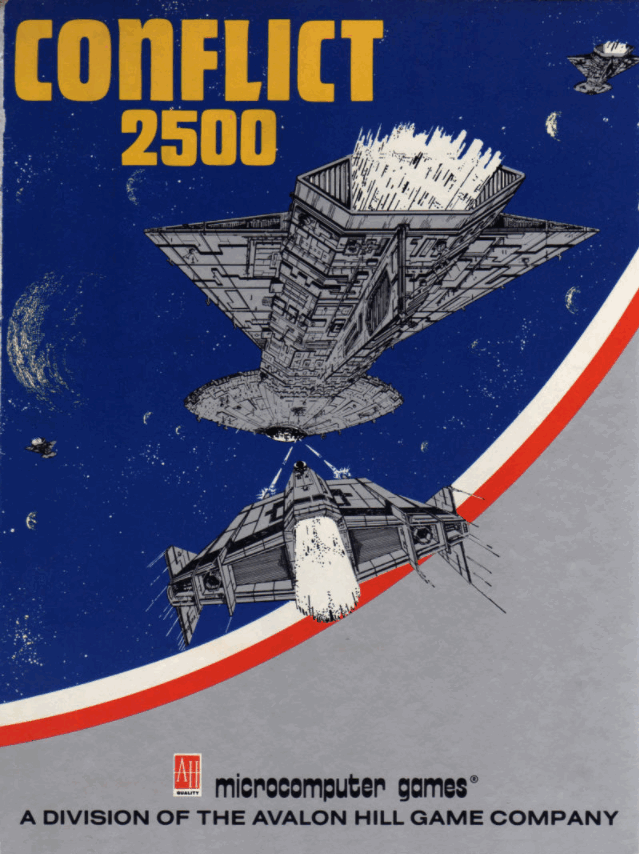
Well, Lieutenant Narwhal. This is going to be a difficult battle. The enemy is invisible , almost immune to damage, and wants no less than to destroy our planet. You’re our last hope, since no one else rose up to the challenge!
WHAT? why wouldn’t anyone volunteer to defend our world against the despicable planet pulverizers?
Because everyone else finds these battles mind-numbingly boring, Lieutenant…
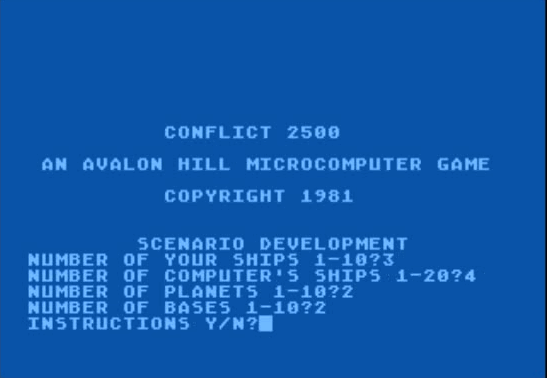
Avalon Hill had attempted to enter the video game market in summer 1980 with a string of wargames that were considered mediocre – though I have some fondness for Nukewar. This relative failure didn’t deter Avalon Hill from publishing more games, some of them not within the scope of this blog : Computer Acquire late 1980 (a business simulation), a string of intriguing adventure games (in 1981 : Lords of Karma and Empire of the Over-Mind), and of course, in 1981, more wargames :
- Chris Crawford’s Tanktics, which I have already covered as technically its first release was in 1978,
- Tom Cleaver’s Galaxy, which I also have covered,
- William Volk’s Conflict 2500 – today’s topic.
Conflict 2500 is Volk’s first game, but he was and still is a prolific developer, in genres going from The Manhole to Leather Goddess of Phobos (for the most well-known titles). In late 1981 Avalon Hill published another one of his games : Voyager I: Sabotage of the Robot Ship, a sort of non-RPG Dungeon Crawler – so not in this blog’s scope either.
Conflict 2500 is about the little-known war against the “planet pulverizers” that took place in the 26th century.
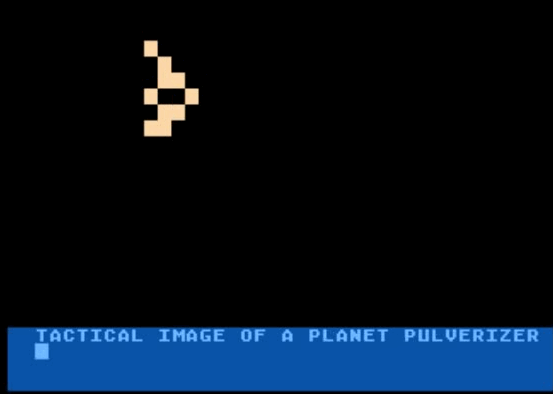
In this particular battle, I will be fighting four planet pulverizers with three “hyperfighters”. There will be two planets to defend, and two starbases for support.
This is the initial situation :
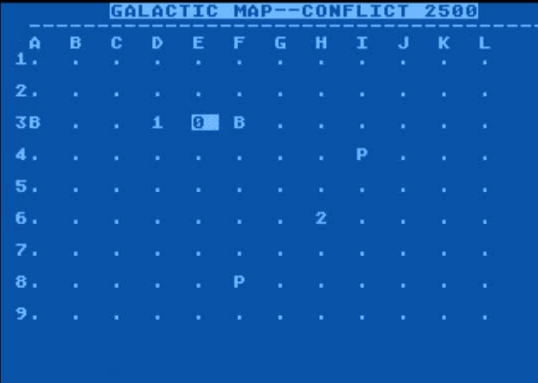
Planet pulverizers are invisible on the galaxy map, you can only see them on the tactical map. I checked the tactical maps of my three ships and no pulverizers in view, so I have some time to prepare.
The starbase on column A is a bit isolated and I will not be able to defend it easily, so I send one of my hyperfighters to drop mines around it. My two other ships go patrol next to the two planets.
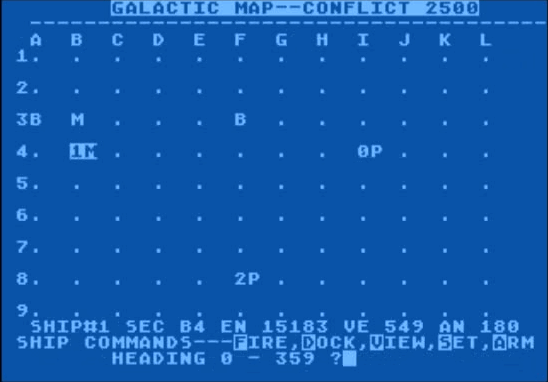
After dropping its second mine, my ship #1 aims to move back to the central starbase when …

Whoops. Ship #1 is gone.
I have 2 ships left against 4 planet pulverizers. Oh well, the manual claims that :

If 3 against 20 is doable, I should be able to manage 2 against 4, right ?
Still no sign of the planet pulverizers, so I use the time I have to drop more mines near my planets, just in case :
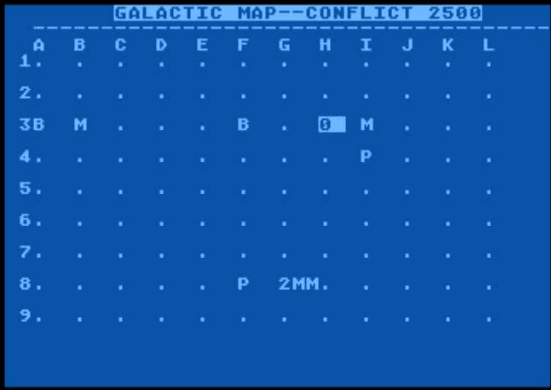
I check my “tactical view”, which zooms on my ships:
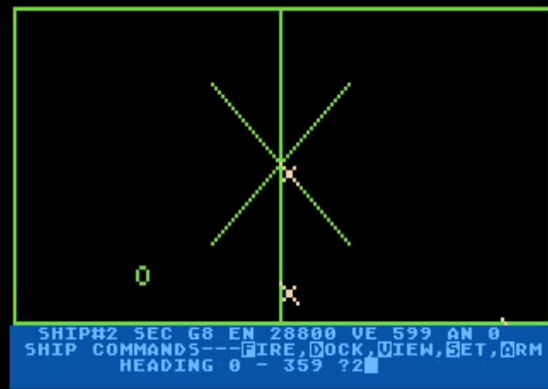
The 0 is the planet. The two weird crosses are the mines. That small thing in the bottom right corner is a planet pulverizer, but I only noticed it when reviewing my screenshots.
And consequently, the following turn :

Well, here they come. Happily enough, my ship #2 is already there, and engages the enemy :
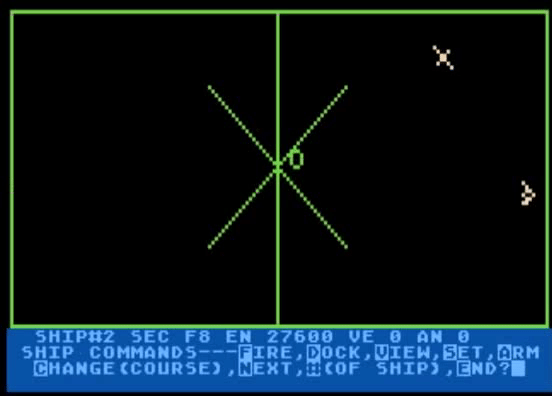
To attack the enemy, you need to input an angle. Attacks use energy (50x the attack power you select), but I can refuel to up to 30 000 energy whenever I am next to a planet.
Planet pulverizers are very sturdy, so I am bringing ship #0 in reinforcement. Ships can travel as much as 5 000 distance units by turn – at the cost of 5 000 energy, but since there is a planet I can use to refuel at my destination, it is no big deal.
Good call to bring reinforcements, because it turns out that my planet in sector F8 is attacked by no less than 3 pulverizers !
This is my view the following turn :
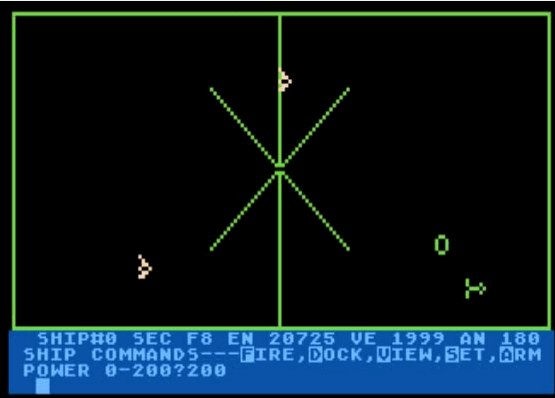
I am still a bit too far from the planet to reload my energy (you need to fine-tune the approach thanks to the tactical map) but I am in perfect position to shoot one of the planet pulverizers : angle 0°.
The following turn, I bring ship #0 next to the planet and focus my fire on the first pulverizer I had detected :
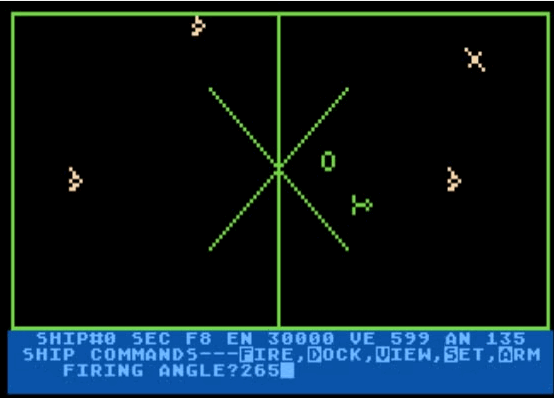
It takes several turns and maybe 7 total hits to destroy that first pulverizer :
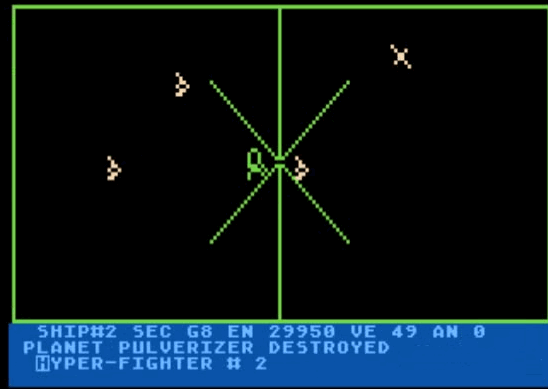
Meanwhile, my other planet is under attack by the fourth and last planet pulverizer, and planet F8 is badly battered by the concentrated fire of the remaining enemies.
Eventually, said planet is, well, pulverized. There is no message to tell me it is gone, I need to see it myself on the tactical map :
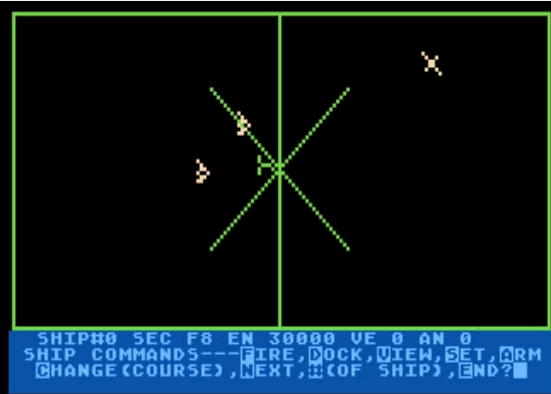
I try to finish off the pulverizers, but they are stronger than my hyperfighters :

My last hyperfighter is also hit, which reduces its energy (energy is also the HP reserve). I need to reach a place where I can refuel. Planet I4 is under attack, and I risk being intercepted, but the starbase in F3 seems safe. I have barely enough energy for a jump though :
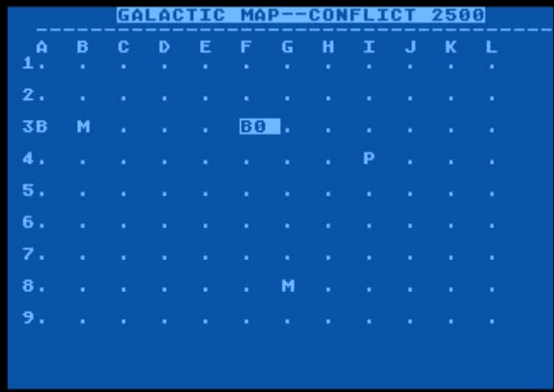
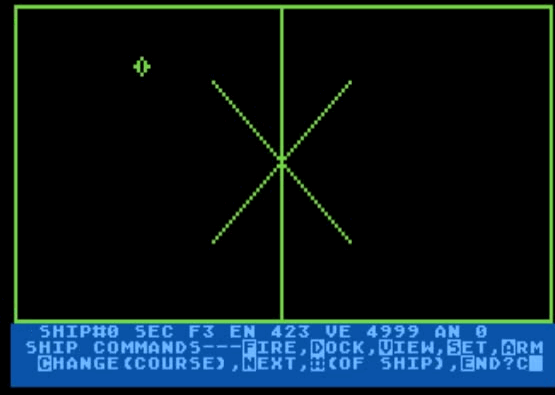
Too far ! I have 423 energy left, so I gamble 400 energy on a last jump, hoping to be close enough to refuel in the starbase. I also hope my last planet will survive.
Not sure what happened next. I don’t think my hyperfighter was attacked, but my last planet is destroyed, which triggered – I believe – the destruction of my last hyperfighter :
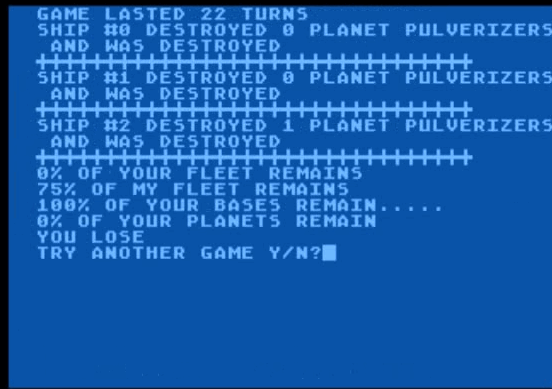
Defeat. Oh well, at least I’m thankful it’s over.
Review & Rating
Conflict 2500 by William Volk, published by Avalon Hill, USA
First release : 1981 on Apple II, Commodore PET, Atari and TRS-80
Tested on : Atari
Total Hours Tested : 2
Average duration of a campaign: 20 minutes for a small battle,
Difficulty: Easy (1/5)
Final Rating: Totally obsolete.
A. Immersion
Context ? “We don’t do that here“. There is no context whatsoever in this game including in the manual, except that it is about “space conflict in the 26th century”.
As for the graphics, you have seen all of them.
Score : Terrible
B. UI , Clarity of rules and outcomes
For such a simple game, there are many UI issues :
- You have no information about the exact coordinate of the planets, so if you want to jump in range to refuel you need to first do an inaccurate jump using the galaxy map, and then the following turn a fine-tune with the tactical map. Of course, since all jumps cost energy (which is also your HP and your ammunition), this can leave you stranded in space,
- The commands are really not optimized. If you want to change the view, the game asks you which view you want even though there are only two views available (so if you want to change, there is only one option). When you refuel, the game asks you whether you want to refuel from a planet, a starbase or another ship, when refueling from a planet is ALWAYS the best option (and in any case, there is almost never more than one option available),
- There are various display issues, minor but irritating – you can see some in the After Action Report,
As for clarity of outcomes, you have no idea how much damage you dealt, how much HP the planet pulverizers have or whether your planets are about to become dust or are pretty fine.
Score : Terrible
C. Systems
Just like in Star Trek, your ships have really only one value : energy. It does everything. Want to move ? That will be one energy by distance unit (a dot in the galaxy map is 1 000 distance units). Want to shoot ? It costs energy. Been hit ? Energy.
If you are next to a planet, you can refuel 30 000 energy for free at any time. Starbases only refuel to 10 000 energy, which is really not much given a max energy shoot is 5 000 energy.
Finally, you can drop mines (maximum : 2 per ship), but I cannot judge their efficiency. Sometimes I got planet pulverizers to blow up on a mine… but they didn’t seem too damaged.
As for combat, you have seen it : pick a direction for your shot, how much energy you invest (but no reason not to spend the maximum if you are next to a planet) and then hope for the best.
Overall, uninteresting, I don’t see much tactical nor strategic layer.
Score : Terrible
D. Scenario design & Balancing
You get to design your own scenarios which in practice means you determine how many hyperships, planet pulverizers, planets and starbases there are. Starbases are inferior planets, since all they do is refuel, but less so than planets. You have no idea about what makes an interesting scenario from the manual.
As for balancing and AI, planet pulverizers beeline for your planets (which is logical, since your hyperships cannot be destroyed if they are in range of a planetary refuel), and the only thing stopping you from stopping them is their ungodly amount of HP.
Score : Terrible
E. Did I make interesting decisions ?
No.
F. Final rating
Totally obsolete. Born obsolete actually.
I actually wondered “is this game a wargame ?“. But if it is not a wargame, what could it be ? It is obviously not a RPG nor an adventure game. Clearly not an arcade or an action game either. It has strategic and tactical movement, resource allocation (your hypé”erships and, at a lower level, energy) – everything a wargame has. It is a wargame – but a terrible one.
Contemporary Reviews
I think it should be pretty clear I hated the game. Contemporary reviewers… did not hate it. They did not love it either, but they found the game acceptable. The Space Gamer reviewer called it “not great, but easily worth fifteen bucks” (issue 45 in November 1981). The Analog Computer Magazine reviewer seemed very irritated at the bugs and UI issues, but still concluded that “it is a nice addition to the game shelf” (issue 4, September 1981), though at least 1980 Micro called it “very dull”… in its 1983 “Reviews of TRS-80 games“.
Whether the tepid reviews that Conflict 2500 received in 1981 are a testament to the lack of alternatives, a testament to maybe my poor understanding of the game … or to the volume of ads that Avalon Hill was paying for in those early video game magazines I don’t know.
At least, I am vindicated by the readership of the Space Gamer in May 1982 : when asked to rate all “SF Computer Games“, they put Conflict 2500 second to last. Thankfully the last game, Project Omega, is apparently a peaceful starbase simulator so I will not have to cover it.